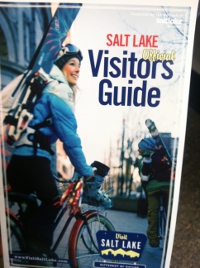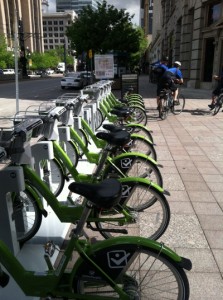Salt Lake City: Way Ahead of San Diego

Thanks to an extremely generous scholarship from Streetsblog, I spent a better part of last week in Salt Lake City for the three-day Congress for New Urbanism Conference. Before the conference, I attended a day-long blogger training session with other bloggers and advocates that are covering the livable streets movement all over the country.
This was my first trip to Salt Lake City and having previously paid scant attention to this city, I was in for a series of pleasant surprises from the minute I landed at the airport. During my entire stay, I couldn’t help but draw comparisons to how far ahead Salt Lake City is from San Diego, California’s second largest city.
Salt Lake City has less than two hundred thousand residents, and yet the city has a light rail line that links the airport to the city’s downtown that was not only convenient but a source of pride for the city’s residents. Earlier this year, San Diego’s mayor Bob Filner called for a trolley link from the city’s airport to downtown. But it’s going to be a while before we get a trolley system, let alone a light rail. In fact our poor connectivity in transit should be a source of embarassment given the attention we’ve received in national circles.
Walking from my train stop to my hotel, I noticed how quiet the city was and how pleasant of an environment all the trees along Main Street provided. The sidewalk was amply wide and well maintained and well lit. I somehow doubt that the Stumblr is needed in that city.
The following day, the Streetsblog blogger training featured luminaries such as Aaron Naparstek and Mike Lydon detailing specific

strategies on changing the public debate on what constituted livable cities complete with examples of success. The training was held in Salt Lake City’s stunningly beautiful library with unfettered views of the neighboring mountains and cityscape. I couldn’t help but notice their library hours – open far more frequently than our own Central library.
After the blogger training, I attended the three day Congress for New Urbanism conference which was very illuminating in learning how the different pieces of a cityscape and governance all fit into one another. There were sessions on community building, on how small changes in one’s environment can lead to big behavioral changes, and how desperately people want to connected with one another – something that is a challenge in a car-centric city like ours. I was able to meet and talk with other leaders around the country on how they were effecting change within the private, public and non-profit sectors. Listening to the speakers and my colleagues, I did experience a bit of despair.
Despite living in a city where 93% of trips are made by private motor vehicle, I sometimes forget how far behind we are from other cities around the country and the world. It certainly took less than eleven months for change to happen on Montezuma Road, but so many of our 2,960 miles of roads need some drastic redesigning and change. Besides missing bike infrastructure, our city is gaining publicity for our poorly maintained sidewalks and roads. Many of the conference attendees remarked at how wide Salt Lake City’s roads were and I had to stop myself many times from talking about how much wider San Diego’s streets were – that wasn’t anything worth bragging about. Many of the conference attendees I met were confused on why San Diego was not on the world stage for livability issues. Nearly everyone described our near perfect weather as a reason on why we ought to be on the forefront of the movement. But we’re not. We have to catch up to cities as large as New York City, as similar as Los Angeles and Long Beach and as tiny as Salt Lake City.
I am certainly pleased with the leadership that San Diego has demonstrated in recent months. But on my return flight home, I read the news that the Plaza de Panama Committee had appealed the judicial ruling on Balboa Park. This committee had been touting a plan to build a bridge and an 800-space parking garage in the middle of Balboa Park. The committee disagreed with the judicial ruling about the plan which was proposed and promoted as a solution to create a pedestrian free plaza in the middle of the park.
Given how much public space we have handed out and continue to hand out to the automobile at the expense of human life and creating quality public spaces, I was and am embarrassed at how little we had accomplished in comparison with other cities around the country. To paraphrase city traffic engineer, Brian Genovese, there is so much work that needs to be done and done quickly. We cannot as a city afford to tip toe around the automobile that despite decades of funding subsidies and support continues to fail in delivering its purported results while giving a us a black eye on the national and international stage.
To read more coverage about the CNU21 conference and about the the Streetsblog network here are a sampling of a few excellent posts by my colleagues discussing Salt Lake City’s bike share program, the language bias inherent in transportation engineering, an interview with Jason Roberts, and recaps of the conference by Steve Mouzon.
